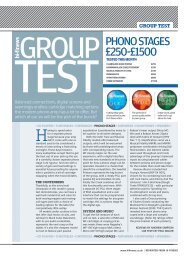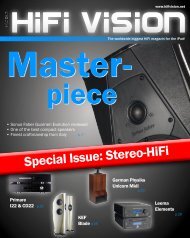PDF file - Primare
PDF file - Primare
PDF file - Primare
Create successful ePaper yourself
Turn your PDF publications into a flip-book with our unique Google optimized e-Paper software.
<strong>Primare</strong> Reviews<br />
CD22 and I22<br />
CD player (£1,250); amplifier (£1,250)<br />
such attractive hardware. It does<br />
everything, of course (controlling a<br />
complete <strong>Primare</strong> system if you’ve<br />
got one), but it just looks a bit, well,<br />
cheap and cheerful. End of complaint<br />
– one can’t have everything!<br />
The CD22 is a conventional beast<br />
underneath its top cover, with an<br />
audio CD transport (not a CD-ROM<br />
one – luckily, those slow, noisy things<br />
seem to have fallen out of favour<br />
almost everywhere), a control board,<br />
a linear power supply with an R-core<br />
transformer and a dedicated D-A and<br />
audio output board. This last carries<br />
most of the mission-critical stuff,<br />
including the DAC chip and the<br />
upsampling chip or Asynchronous<br />
Sample Rate Convertor (ASRC).<br />
Upsampling flexibility<br />
It’s not at all unusual to find an ASRC<br />
in a CD player, where they are used<br />
both for their digital filtering<br />
“We’ve seldom heard<br />
energy and detail so<br />
well balanced in an<br />
affordable system.”<br />
(upsampling) and jitter-reduction<br />
properties, but <strong>Primare</strong> has applied<br />
an unusual twist here in offering<br />
various upsampling options: none,<br />
48kHz, 96kHz and 192kHz. If ‘none’<br />
is selected there is still digital<br />
filtering applied by the DAC, though<br />
its precise characteristics are noticeably<br />
different from those of the ASRC.<br />
The really unusual feature is the<br />
option of 48kHz upsampling, which<br />
most manufacturers evidently regard<br />
as not worth bothering with. There’s<br />
no obvious reason why not, though,<br />
and although the response in this<br />
mode is very similar indeed to that<br />
for 96kHz or 192kHz upsampling it’s<br />
RECOMMENDED<br />
DETAILS<br />
FEATURES:<br />
•I22: Single<br />
loudspeaker output<br />
Four line inputs<br />
• Optional digital<br />
input board -<br />
electrical. optical<br />
and USB inputs<br />
• Preamp and<br />
recording line<br />
outputs<br />
• DAC board (£340)<br />
Distributor:<br />
Karma AV<br />
Telephone:<br />
01423 358846<br />
Website:<br />
primare.se<br />
not absolutely identical and it’s<br />
perfectly possible that sound will<br />
differ a little.<br />
For the rest, features are a largely<br />
standard set. The player will read<br />
data discs with MP3 and WMA <strong>file</strong>s<br />
on them and also features a USB-A<br />
socket at the rear for USB sticks with<br />
the same formats of <strong>file</strong>s. There are<br />
digital outputs (electrical and<br />
optical) and a dimmable display.<br />
Everything is very well assembled,<br />
but nothing out of the ordinary.<br />
The switch routine<br />
The I22 is rather less traditional,<br />
mainly because of its employment of<br />
Class D for the power amplification.<br />
In fact, <strong>Primare</strong> has gone to town on<br />
this and developed its own Class D<br />
amplifier circuit, something relatively<br />
few hi-fi specialists have done as<br />
there are some very decent preassembled<br />
modules available.<br />
<strong>Primare</strong>’s ‘Ultra-Fast Power Device’<br />
circuit reckons to improve on these,<br />
not least through the implications of<br />
the ‘ultra-fast’ bit. The claimed<br />
‘instantaneous’ rise time of the circuit<br />
may be physically impossible, but it’s<br />
a well-established fact that switching<br />
power amps work better if they can<br />
switch faster and <strong>Primare</strong> has<br />
evidently put some work into<br />
achieving exactly that.<br />
The other feature that makes this<br />
circuit work well is the way the<br />
output filter has been integrated into<br />
the design, rather than being a<br />
separate module added on after the<br />
amp proper was signed off as a<br />
design. To be fair, some other current<br />
designs do this, but it was not always<br />
thus and poorly executed output<br />
filters probably had a lot to do with<br />
the dodgy reputation enjoyed by<br />
Class D in its early days. <strong>Primare</strong><br />
explains that the way the amplifier<br />
and filter have been designed<br />
together means that feedback around<br />
the circuit is constant over the audio<br />
band, a highly desirable state-ofaffairs<br />
in any amplifier circuit and<br />
generally quite tricky to arrange.<br />
Switching technology is also used<br />
in the power supply for the I22,<br />
which is a switch-mode type. Again,<br />
these have been accused of causing<br />
all sorts of problems because the<br />
noise they inject into the mains<br />
wiring, but it ain’t necessarily so;<br />
and it’s hardly as if conventional<br />
transformer-based supplies are<br />
blameless either. This supply circuit<br />
benefits from ‘power factor<br />
correction’, which to some extent<br />
alleviates the noise and makes the<br />
amp a much friendlier load on the<br />
mains supply.<br />
www.hifichoice.co.uk Reprinted from : www.hifichoice.co.uk<br />
57





